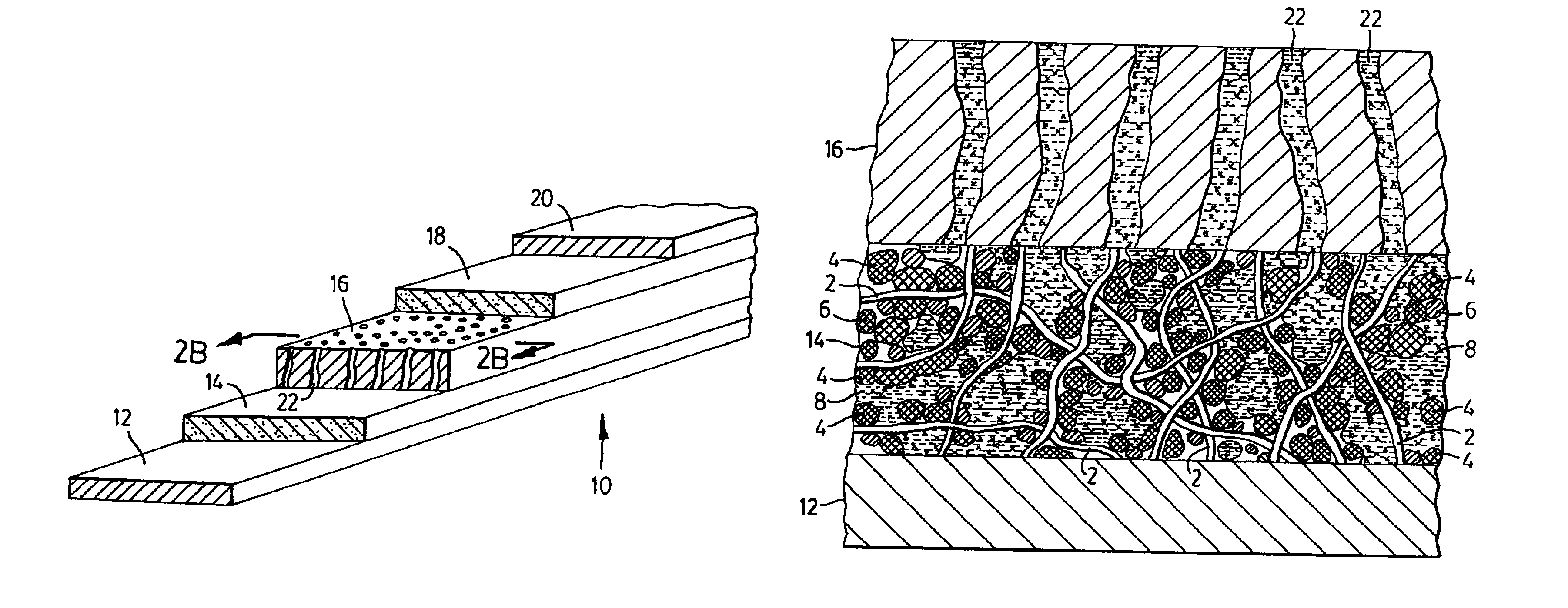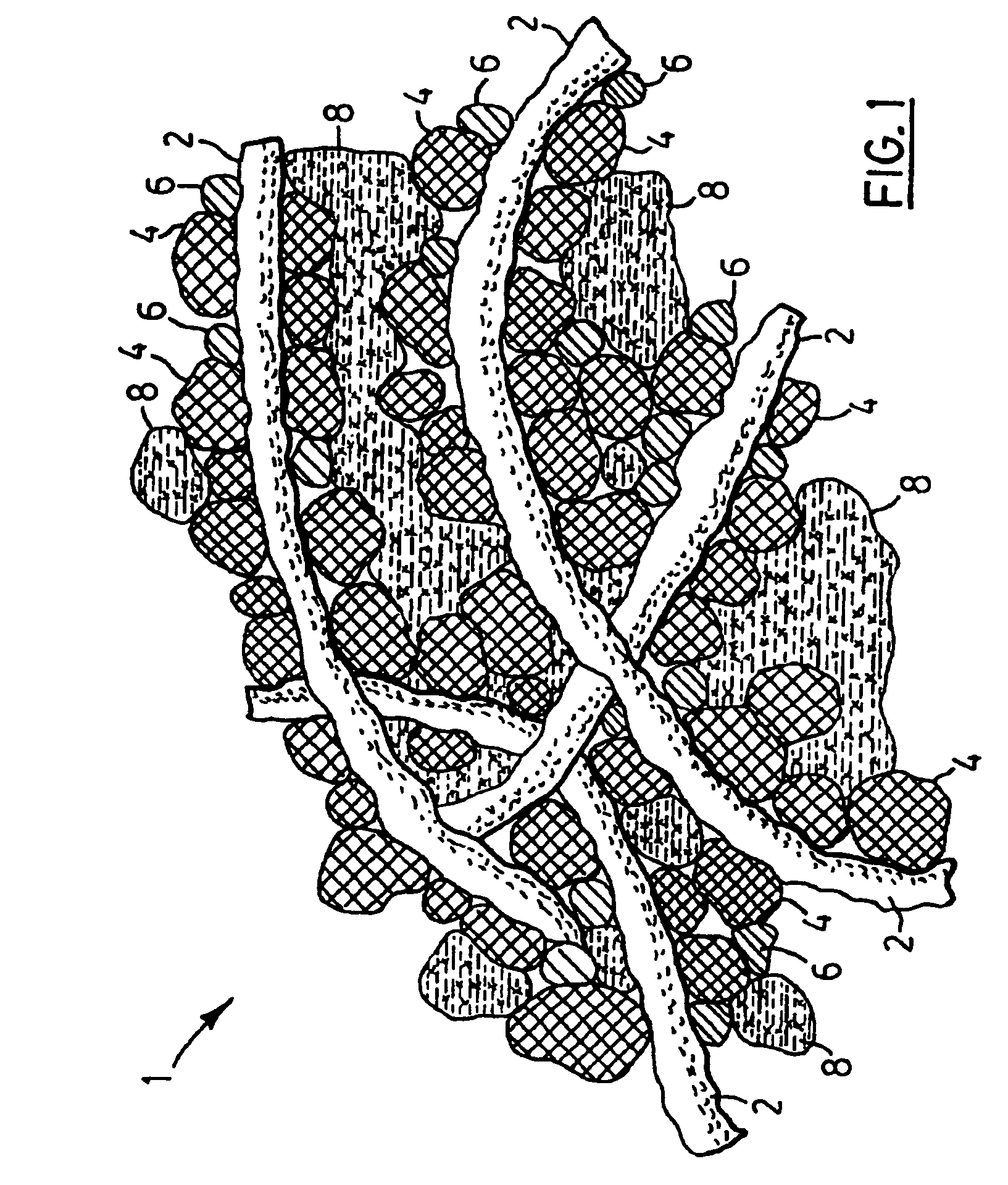Particulate electrode including electrolyte for a rechargeable lithium battery
a lithium battery and lithium ion technology, applied in the field of electrochemical cells, can solve the problem of organic liquid loss by seepag
- Summary
- Abstract
- Description
- Claims
- Application Information
AI Technical Summary
Benefits of technology
Problems solved by technology
Method used
Image
Examples
example 1
[0038]Polymer electrolyte filaments were obtained by conventional filament spinning methods utilizing a solution of polyvinylidene fluoride and polyethylene oxide in acetone, also containing lithium phosphofluoride (LiPF6) in 10 wt. % based on the solid content. The polymer filaments obtained were pliable, had a somewhat tacky surface at room temperature and had average length of 12 μm, and 0.8 μm diameter. The filaments were first wetted by about 2 wt. % of acetone and were mixed with meso-phase graphite particles (MCMB) having average particle size of 10 μm, manufactured by Osaka Gas Co., in a weight ratio of polymer filaments to graphite=6:94. The mixture was obtained by hand mixing and subsequently spread in 200 μm layer thickness by doctor's blade method on a 10 μm thick copper foil. The negative electrode layer so obtained was saturated with an organic electrolyte solution made of ethylene carbonate-dimethyl carbonate, containing LiPF6 in 1 M concentration. Subsequently, the f...
example 2
[0039]Polymer filaments were obtained from a suspension of VdF:HFP copolymer marketed as KYNAR FLEX 2750, in (NMP), also containing 7 wt. % Lithium perchlorate (LiClO4) based on solid content of the solution, by conventional extrusion. The solid, lithium compound bearing polymer filaments having a tacky surface were mixed with MCMB graphite particles as in Example 1, to form the negative electrode of a rechargeable lithium electrochemical cell. A multi-layer porous separator was painted with 2 wt. % solution of VdF:HFP copolymer in NMP also containing LiClO4 on one of its faces and the solvent allowed to evaporate. The separator was placed on the negative electrode layer with the coated face being in contact with the polymer filament bearing electrode layer. The positive electrode was prepared utilizing the same lithium compound containing, solid polymer electrolyte filaments as in the negative electrode, mixed with lithium-manganese oxide (LiMnO2) and fine carbon, in a ratio of LiM...
example 3
[0040]The electrodes of another rechargeable lithium battery were prepared from electro-active particles and solid, lithium ion conducting polymer filaments as described in Example 2, however, the multi-layered inert, polymer separator in this lithium ion cell was dipped in 2 wt. % VdP:HFP copolymer solution in NMP also containing lithium perchlorate, thus providing a polymer separator coated with an ion conducting, solid, polymer layer having adhesive surface, on each face to be in contact with the negative and positive electrode, respectively. The assembled electrodes and the separator coated with solid polymer electrolyte on both faces was subsequently placed between the current collectors, and was impregnated with lithium arsenofluoride containing organic electrolyte as in Example 2. The solid content of the obtained lithium cell structure was 62.4 wt. % the balance being non-aqueous liquid electrolyte. Finally, the lithium electrochemical cell obtained was packaged and sealed i...
PUM
| Property | Measurement | Unit |
|---|---|---|
| diameter | aaaaa | aaaaa |
| lengths | aaaaa | aaaaa |
| lengths | aaaaa | aaaaa |
Abstract
Description
Claims
Application Information
 Login to View More
Login to View More - R&D
- Intellectual Property
- Life Sciences
- Materials
- Tech Scout
- Unparalleled Data Quality
- Higher Quality Content
- 60% Fewer Hallucinations
Browse by: Latest US Patents, China's latest patents, Technical Efficacy Thesaurus, Application Domain, Technology Topic, Popular Technical Reports.
© 2025 PatSnap. All rights reserved.Legal|Privacy policy|Modern Slavery Act Transparency Statement|Sitemap|About US| Contact US: help@patsnap.com



